Top Rankings
Levy School District ranks among the top 20% of public school district in Florida for:
Category
Attribute
Graduation Rate
Highest graduation rate (Top 20%)
For the 2025 school year, there are 10 public middle schools serving 3,003 students in Levy School District. This district's average middle testing ranking is 2/10, which is in the bottom 50% of public middle schools in Florida.
Public Middle Schools in Levy School District have an average math proficiency score of 42% (versus the Florida public middle school average of 53%), and reading proficiency score of 39% (versus the 52% statewide average).
Minority enrollment is 31% of the student body (majority Hispanic), which is less than the Florida public middle school average of 66% (majority Hispanic).
Overview
This School District
This State (FL)
# Schools
15 Schools
1,745 Schools
# Students
5,618 Students
1,042,011 Students
# Teachers
294 Teachers
54,708 Teachers
Student : Teacher Ratio
19:1
19:1
District Rank
Levy School District, which is ranked within the bottom 50% of all 73 school districts in Florida (based off of combined math and reading proficiency testing data) for the 2021-2022 school year.
The school district's graduation rate of 93% has increased from 80% over five school years.
Overall District Rank
#57 out of 73 school districts
(Bottom 50%)
(Bottom 50%)
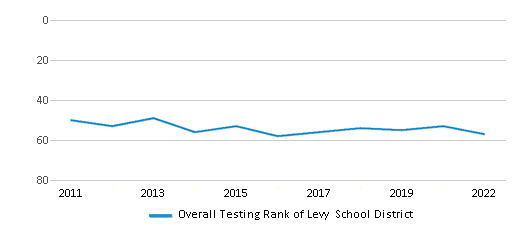
Math Test Scores (% Proficient)
45%
52%
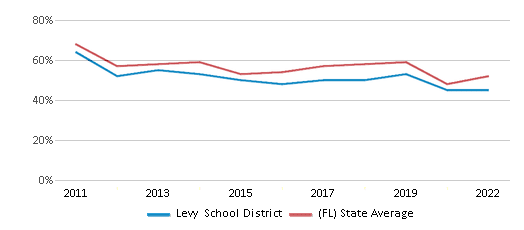
Reading/Language Arts Test Scores (% Proficient)
43%
52%
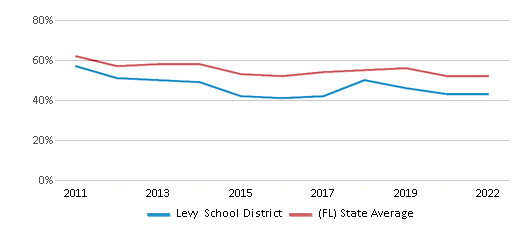
Science Test Scores (% Proficient)
42%
52%
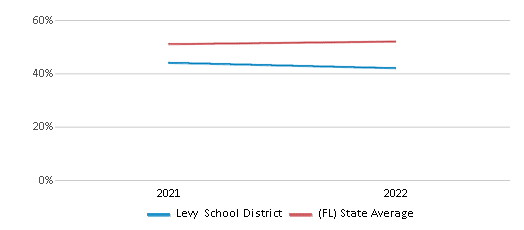
Graduation Rate
93%
87%
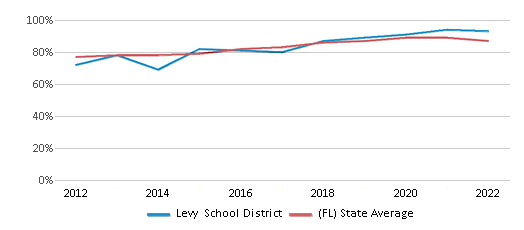
Students by Ethnicity:
Diversity Score
0.54
0.70
# American Indian Students
11 Students
2,890 Students
% American Indian Students
n/a
n/a
# Asian Students
38 Students
29,883 Students
% Asian Students
1%
3%
# Hispanic Students
893 Students
401,138 Students
% Hispanic Students
16%
38%
# Black Students
669 Students
215,725 Students
% Black Students
12%
21%
# White Students
3,651 Students
349,085 Students
% White Students
65%
34%
# Hawaiian Students
3 Students
1,862 Students
% Hawaiian Students
n/a
n/a
# Two or more races Students
353 Students
41,428 Students
% of Two or more races Students
6%
4%
Students by Grade:
# Students in PK Grade:
243
6,785
# Students in K Grade:
422
37,786
# Students in 1st Grade:
453
39,534
# Students in 2nd Grade:
460
40,863
# Students in 3rd Grade:
461
42,129
# Students in 4th Grade:
429
42,303
# Students in 5th Grade:
414
42,249
# Students in 6th Grade:
407
201,326
# Students in 7th Grade:
422
223,117
# Students in 8th Grade:
439
218,377
# Students in 9th Grade:
376
37,509
# Students in 10th Grade:
382
38,273
# Students in 11th Grade:
389
34,944
# Students in 12th Grade:
321
36,816
# Ungraded Students:
-
-
District Revenue and Spending
The revenue/student of $10,643 in this school district is less than the state median of $11,962. The school district revenue/student has stayed relatively flat over four school years.
The school district's spending/student of $12,533 is higher than the state median of $11,615. The school district spending/student has stayed relatively flat over four school years.
Total Revenue
$60 MM
$34,349 MM
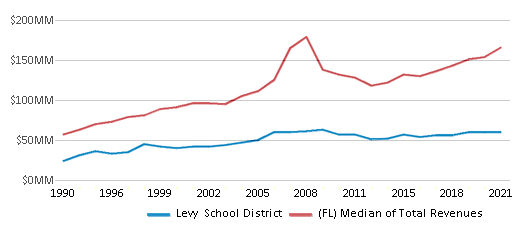
Spending
$70 MM
$33,354 MM
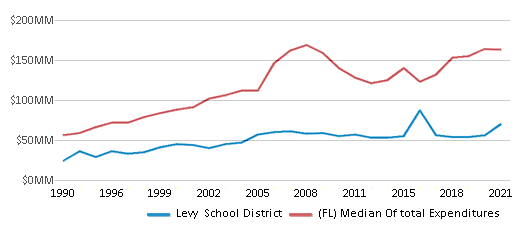
Revenue / Student
$10,643
$11,962
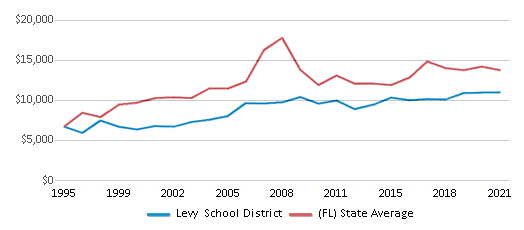
Spending / Student
$12,533
$11,615

Best Levy School District Public Middle Schools (2025)
School
(Math and Reading Proficiency)
(Math and Reading Proficiency)
Location
Grades
Students
Rank: #11.
Cedar Key High School
(Math: 50-54% | Reading: 55-59%)
Rank:
Rank:
7/
Top 50%10
951 Whiddon Ave
Cedar Key, FL 32625
(352) 543-5223
Cedar Key, FL 32625
(352) 543-5223
Grades: PK-12
| 193 students
Rank: #22.
Chiefland Middle High School
(Math: 46% | Reading: 40%)
Rank:
Rank:
4/
Bottom 50%10
808 N Main St
Chiefland, FL 32626
(352) 493-6000
Chiefland, FL 32626
(352) 493-6000
Grades: 6-12
| 830 students
Rank: #33.
Bronson Middle/high School
(Math: 47% | Reading: 37%)
Rank:
Rank:
4/
Bottom 50%10
351 Ishie Ave
Bronson, FL 32621
(352) 486-5261
Bronson, FL 32621
(352) 486-5261
Grades: 6-12
| 523 students
Rank: #44.
Yankeetown School
(Math: 40-44% | Reading: 35-39%)
Rank:
Rank:
3/
Bottom 50%10
4500 Highway 40 W
Yankeetown, FL 34498
(352) 447-2372
Yankeetown, FL 34498
(352) 447-2372
Grades: PK-8
| 244 students
Rank: #55.
Nature Coast Middle School
Charter School
(Math: 30-34% | Reading: 40-44%)
Rank:
Rank:
3/
Bottom 50%10
6830 Nw 140th St
Chiefland, FL 32626
(352) 490-0700
Chiefland, FL 32626
(352) 490-0700
Grades: 6-8
| 84 students
Rank: #66.
Williston Middle High School
(Math: 36% | Reading: 38%)
Rank:
Rank:
3/
Bottom 50%10
350 Sw 12 Ave
Williston, FL 32696
(352) 528-3542
Williston, FL 32696
(352) 528-3542
Grades: 6-12
| 1,126 students
Rank: n/an/a
Jail Services
Alternative School
480 Marshburn Dr
Bronson, FL 32621
(352) 486-5231
Bronson, FL 32621
(352) 486-5231
Grades: PK-12
| n/a students
Rank: n/an/a
480 Marshburn Dr
Bronson, FL 32621
(352) 486-5231
Bronson, FL 32621
(352) 486-5231
Grades: 6-12
| 3 students
Rank: n/an/a
480 Marshburn Dr
Bronson, FL 32621
(352) 486-5231
Bronson, FL 32621
(352) 486-5231
Grades: K-12
| n/a students
480 Mashburn Dr
Bronson, FL 32621
(352) 486-5231
Bronson, FL 32621
(352) 486-5231
Grades: K-12
| n/a students
Recent Articles

Sexual Harassment at Age 6: The Tale of a First Grade Suspension
A six-year old in Aurora, Colorado, was suspended after singing an LMFAO song to a little girl in his class and reportedly “shaking his booty.” We look at the case and the sexual harassment problem in public schools today.

How Scaffolding Could Change the Way Your Child Learns
This article explores the concept of instructional scaffolding, a teaching method that enhances learning by breaking down complex tasks into manageable parts. It highlights how scaffolding supports students in developing critical thinking skills and becoming more independent learners. The article discusses the benefits of scaffolding, including improved engagement and reduced anxiety, and provides strategies for its implementation across various educational levels.

February 05, 2025
Understanding the U.S. Department of Education: Structure, Impact, and EvolutionWe explore how the Department of Education shapes American education, from its cabinet-level leadership to its impact on millions of students, written for general audiences seeking clarity on this vital institution.





